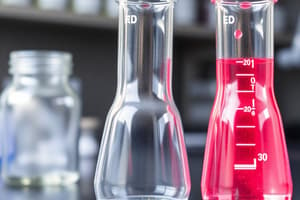Podcast
Questions and Answers
What is the standard electrode potential of Lithium?
What is the standard electrode potential of Lithium?
- -2.37 V
- -3.01 V (correct)
- -0.76 V
- +0.34 V
The standard hydrogen electrode (SHE) has a positive standard electrode potential of +0.76 V.
The standard hydrogen electrode (SHE) has a positive standard electrode potential of +0.76 V.
False (B)
What is the significance of the electrochemical series?
What is the significance of the electrochemical series?
It arranges metals in order of their standard reduction potentials.
The standard electrode potential is measured under standard conditions at ___ degrees Celsius.
The standard electrode potential is measured under standard conditions at ___ degrees Celsius.
Match the following metals with their standard electrode potential (E0):
Match the following metals with their standard electrode potential (E0):
Which element has the highest tendency for reduction?
Which element has the highest tendency for reduction?
Metals with a higher reduction potential are more easily oxidized.
Metals with a higher reduction potential are more easily oxidized.
What does a positive E0 value indicate about a redox reaction's spontaneity?
What does a positive E0 value indicate about a redox reaction's spontaneity?
________ is the gradual deterioration of a metal or alloy by the chemical or electrochemical reaction with the environment.
________ is the gradual deterioration of a metal or alloy by the chemical or electrochemical reaction with the environment.
Match the metals with their behavior towards hydrogen displacement:
Match the metals with their behavior towards hydrogen displacement:
Flashcards are hidden until you start studying
Study Notes
Standard Electrode Potential (E⁰)
- The tendency of a metal electrode to lose or gain electrons when in a solution of its own ions with a 1M concentration at 25°C.
Electrochemical Series or EMF Series
- Arranges metals in order of increasing standard reduction potential on the hydrogen scale.
- The standard hydrogen electrode (SHE) is used as a reference point with a potential of 0.00 V.
- Metals with higher positive standard reduction potentials have a greater tendency to be reduced.
- Metals with lower negative standard reduction potentials have a greater tendency to be oxidized.
- Fluorine has the highest positive potential (+2.87 V) and is easily reduced.
- Lithium has the highest negative potential (-3.02 V) and is easily oxidized.
Significance of EMF Series or Applications of Nernst Equation
- Calculating Standard Cell EMF: The standard cell potential (E⁰cell) is found by subtracting the standard electrode potential of the left electrode from the standard electrode potential of the right electrode ( E⁰cell = E⁰right - E⁰left).
- Relative Ease of Oxidation or Reduction: Metals higher in the series are more easily oxidized, while those lower in the series are more easily reduced.
- Displacement Reactions: Metals higher in the series can displace metals lower in the series from their solutions. For example, Copper can displace Silver from its solution, and Iron can displace Copper.
- Determining Equilibrium Constant (K): The equilibrium constant (K) can be calculated from the standard cell potential using the formula log K = (nFE⁰) / 2.303RT.
- Hydrogen Displacement: Metals with negative standard reduction potentials (above Hydrogen in the EMF series) can displace hydrogen from acid solutions. Zinc will displace H₂ from dilute acids, while Silver cannot.
- Predicting Redox Reactions: If the standard cell potential (E⁰) is positive, the reaction is spontaneous (ΔG = negative). If E⁰ is negative, the reaction is non-spontaneous (ΔG = positive).
Corrosion
- The gradual deterioration of a metal or alloy due to chemical or electrochemical reactions with the environment.
- Examples include rusting of iron, blackening of silver, and fogging of nickel.
Theory of Electroplating of Copper
- Uses a copper anode in the electrolytic cell, ensuring a constant concentration of copper ions in the electrolyte.
- Copper ions move to the cathode (the item being plated) and are deposited as copper metal: Cu²⁺ + 2e⁻ → Cu
- Sulfate ions move to the copper anode and dissolve copper to replenish the electrolyte: Cu²⁺ + SO₄²⁻ → CuSO₄
Uses of Copper Plating
- Undercoat for chrome plating.
- Smoothing out surface irregularities.
- Protective coating for steel articles.
- Used in cooking utensils to improve heat transfer (copper bottom).
Factors Influencing Electroplating
- Polarization: The buildup of back EMF during electrolysis, which slows the reaction rate.
- Electrolyte Concentration: High electrolyte concentration ensures better conductivity, but lower concentrations provide more uniform deposition.
- Additives: Components added to the bath to improve deposit quality:
- Complexing Agents: Used to control metal ion concentration, enhance throwing power (deposit uniformity), and increase the solubility of sparingly soluble salts.
- Brighteners: Used to produce bright and lustrous deposits.
- Levelers: Help form a uniform deposit by preferential adsorption at areas of rapid deposition.
- Structure Modifiers: Alter the structure of the deposit and affect its properties.
- Wetting Agents: Remove adsorbed hydrogen from the cathode to prevent pitting.
- Thickness of Deposition: Determined by the desired properties of the coating.
- Current Density: The current per unit area of the object being plated. High current density can lead to brittle deposits, while low density makes the process slower.
Electrophoretic Deposition (EPD)
- Technique where charged particles in a stable colloidal suspension are deposited on an oppositely charged conductive substrate under the influence of an electric field.
- Used for various coatings including ceramics, polymers, and metals.
- Benefits include ease of controlling layer thickness and morphology, straightforward apparatus, short preparation time, and cost effectiveness.
- EPD utilizes a stable dispersion of charged particles in a dielectric (non-conducting) fluid.
- The particles move towards the work part due to the electric field, forming a rigid layer.
Characteristics of Electrophoretic Deposition
- Stable dispersion of particles (colloid) in a solvent.
- Particles gain a surface charge through electrostatic interaction with the solvent.
- Particles move toward the work part under the influence of an applied voltage.
- A rigid deposition of condensed particles forms on the work part surface.
- The deposited coating adheres to the work part.
Studying That Suits You
Use AI to generate personalized quizzes and flashcards to suit your learning preferences.




